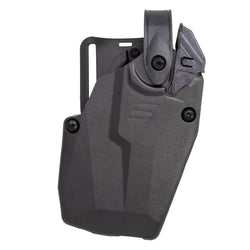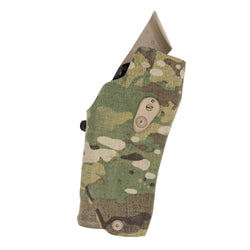More and more law-abiding citizens are choosing to carry concealed, and this month’s skill builder exercise builds on last month’s draw from the holster, focusing on the appendix concealed carry draw.
How The Skill Builder Works
Start each month by shooting the monthly Skill Builder exercise. After completing the drill, record your results in your copy of The Firearms Training Notebook. Use that data to develop your dry fire training plan, and work that plan throughout the month. Toward the end of the month, shoot the Skill Builder again to measure your progress and improvement.
The last couple of months’ Skill Builder exercises were based on the War HOGG Self Eval. Building off your performance from the Self Eval and last month’s holster draw drill, this month we’re focusing on drawing from concealment using an inside-the-waistband holster in the appendix position.
At War HOGG Tactical our goal is to support your firearms training program and help you become more efficient and effective with your firearm. Remember, our mantra is: Be 1% Better Every Day!
Equipment Needed
- Your normal range and firearms equipment
- Live Fire Range
- Dry Fire Training Area
- Shot Timer, we recommend the PACT Club Timer III. Click the link to learn how to use a timer effectively in your marksmanship training.
- The Firearms Training Notebook – available on Amazon
- Recording device and tripod or holder
- 3×5 and 4×6 index cards (targets)

June Skill Builder: Appendix Concealed Carry Draw
This month’s Skill Builder focuses on drawing from concealment in the appendix carry position. When I work on my concealed carry draw, I practice with my hands both above and below the waist.
Head out to the range and run 10 draws from the holster with your hands above the waist, firing one shot each time. Then do another 10 draws with your hands below the waist. Remember—no warm-up, just shoot the drill.
Record your times, marksmanship data, target used, and distance in The Firearms Training Notebook. Be sure to use the notes section at the bottom of the page to capture any observations or lessons learned during that range session. For example: poor grip on the draw, shirt snagging on the pistol, or anything else that stood out during the session.
Clothing Considerations for The Concealed Carry Draw
If you haven’t already, go back and read the article Concealed Carry Considerations, where I talk about my EDC system—everything from holsters and pistols to belts, clothing, and accessories.
In my opinion, the shirt is often overlooked. You need to pay attention to the size and length of your shirts. Personally, I’ve found that some of my shirts have tails that are too long, which can cause them to bunch up or bind when I draw from concealment.

Concealed Carry Draw from Appendix: Progression
I start my draw progression by lifting my shirt and establishing a solid grip on the pistol. This serves two purposes. First, it helps me identify the best place to grab the shirt to clear the holster. With some shirts—especially depending on their length—I have to grab the hem. With others, I find it easier to grab the shirt near the pistol itself. It’s a matter of personal preference and will vary based on your clothing.
Second, this step allows me to work on acquiring a proper grip on the pistol from concealment. Personally, I keep my palm open and slide my thumb down along my body to get behind the grip of the pistol. As the gun clears the holster, I rotate it slightly so that my support hand can receive the pistol and conduct my pistol presentation, December’s skill builder.
Draw From Concealment, Hands Above The Waist — Mechanics
Start with your hands above your waist. On the first beep of the shot timer, quickly move your support hand to grab and raise your shirt, ensuring it fully clears the pistol. This ensures your firing hand does not get caught in your shirt.

The firing hand should move to the pistol with the palm open and the thumb sliding down your body to get behind the pistol at your waistline. Use the web between your thumb and index finger as a reference point to make solid contact with the beavertail of the pistol to establish a proper firing grip. If your hand misses the beavertail, drive your hand forward to make contact and get a good grip on the pistol.
Once a good grip is established, draw the pistol from the holster. Once the pistol has cleared the holster, orient the muzzle horizontally and bring the support hand to build your two-handed grip in the vicinity of your ready position. Remember, the ready position is a reference point, not a pause point.
From there, conduct your full pistol presentation to the target and press the trigger. After the shot, don’t rush to reholster. Focus on good follow-through and recovery.

Draw From Concealment, Hands Below The Waist — Mechanics
Start with your hands below your waist. On the first note of the shot timer, rapidly move both hands into action. The support hand should get to the shirt first to lift and clear it from the holster and pistol. At the same time, the firing hand moves up to the holster, establishes a good grip on the pistol, and draws it clear.
As the firing hand draws the pistol, the support hand moves toward the centerline of your body with the palm open and ready to receive the pistol. Establish a solid two-handed grip, then present the pistol to the target and execute your shot.
Reholstering
In my opinion, there is no rush to get the pistol back in the holster. Look at your holster before reholstering to ensure nothing is obstructing it. Reverse your draw sequence, ensuring your finger is off the trigger. As the pistol goes back into the holster, I recommend placing your thumb on the rear of the slide to ensure the pistol isn’t accidentally bumped out of battery. Once the pistol is safely holstered, reset your shirt and get ready for your next draw.

Making Your Dry Fire Plan
Take your 10 concealed carry draws—both hands above the waist and hands below—and calculate your average time for each. Open a new page in The Firearms Training Notebook and title it “Draw from Concealment.”
Start by adding between 0.25 to 0.50 seconds to your average time. As you begin making consistent dry trigger presses and getting your sights on target at or below your par time, gradually lower it—by 0.10 or even 0.05 seconds at a time. The idea is to keep reducing the time until you are at the best time for your performance.
Remember, don’t get wrapped up in what others are doing for time. This is your firearms journey, and you will get there if you put the time into your dry fire training.
Check On Your Work
Toward the end of the month, return to the range and shoot the same 10 draws from concealment—hands above and below the waist. Compare your results to the beginning of the month. If you’ve been putting in the dry fire work, you should see measurable improvement.
Have Accountability
Accountability is key to progressing in your firearms training. While you can do this on your own, having a shooting partner, tribe, or group will keep you in check.
If you don’t have any accountability, you can always join us in sharing your marksmanship growth. Go to our On The Range (OTR) Patreon “CREW” member’s page or our On The Range Podcast “CREW’ Facebook group page.
Me and my co-host / co-author Mark Kelley of Kelley Defense conduct a bi-monthly interactive Zoom call with our Patreon “CREW” members where we break down each shooter’s skill builder. We have even reviewed video of “CREW’ members shooting during our call and given immediate feedback on where we see they can improve their shooting skills.
Conclusion – Put In The Work
If you want to improve your marksmanship, there’s no substitute for putting in the work. That means having a solid dry fire plan, tracking your progress with tools like The Firearms Training Notebook, and using resources like a shot timer and video review to elevate your training.
Train Hard, Stay Safe and see you “On The Range” —Rick









